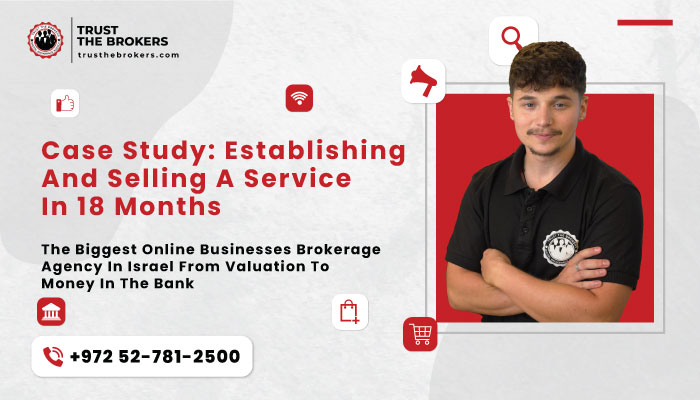A couple of days after Christmas in 2016, I went to the Elk Run Lodge on Vail Mountain and addressed one of the most essential calls of my life. Over the past 6 months, I had spoken to lots of individuals interested in purchasing my company. Ultimately, we came upon an agreement that suits my taste after discussing the transfer procedure for half an hour. In other words, I can sell, move the assets and management and move on. A few weeks passed by and the deal went through. I have the highest amount of money that I’ve ever had my whole life in my bank account, and I can enter a new chapter in my life.
When I was asked if I was interested in offering my organization, I dismissed it as far-fetched. Simpledata, my company, was just a year old then and even though it yielded great earnings every month, I never ever believed it was possible to sell such a modest company. I stopped working to think about a basic reality of organization: all revenues have worth. Unlike a lot of my peers in the innovation trade, I concentrated on constructing a lucrative business from the beginning. Within the initial months, it made thousands of dollars in earnings. And in half a year, it made $17,000 in net revenue.
It was in December of 2015 that a company broker reached out to me and asked if I would consider putting my company in the market. I informed him I wasn’t prepared to market it. However, 6 months later I talked to another brokerage company called Dealflow, who valued the business at double the profits. I showed my interest and started the task of discussing with interested parties.
In the next 6 months, I ‘d get an email from my broker every couple of weeks informing me that he had actually discovered someone who’s interested. We ‘d get on a call and I would address the same queries: how’d you begin the company? What growth opportunity would be best? Why are you putting it on the market?
In the following months, I contemplated my experience establishing SimpleData.
I pondered on the errors that I did, which stopped me from selling at a higher price throughout this duration. I’ve listed below the most significant errors I made, what I found out, and how you can prevent these errors.

How does a business get valued?
Appraisals have constantly puzzled me. I didn’t have a degree of Master in Business Administration, nor have I been employed by a huge consulting company. Whatever knowledge I have about business, I’ve gained from constructing them myself, checking out books, and asking advice from experts. I likewise understood that public businesses get appraised based on the multiples of their profits. For example, as of composing, the typical rate for an S&P 500 business is about 20x profits. It wasn’t up until I put my business on the market that I found out about the easy formula all financiers utilize to value a property.
Financiers value all from stocks, property, and personal business based upon their conjecture of future incomes. If a financier believes that Google is going to continue to grow its revenue — for instance, by branching out to new markets, releasing new items, or lowering its expenses — they will purchase its stock for a high cost. If they do not anticipate an increase in profits, they will prefer to pay less.
So, Rate (P) = Earnings (E) x Multiple (M).
The Multiple represents the worth of a business beyond its revenues, which begs the question: what makes a business important?
Consider the Multiple of a business like a scorecard that demonstrates how well its carrying out on a series of essential metrics or Key Efficiency Indicators (KPIs). Financiers like to see development, so a business’s monthly or yearly development rate is important. Likewise, they like to see high retention of clients, so the retention rate or churn rate is essential as well.
We can expand the M in the equation above more into:
M = growth rate + % of revenue that is recurring + 3rd factor, 4th factor, and so on.
Every factor has various significance related to it. The significance, or if a factor is pondered on, will depend on the financiers. The equation just makes it easier to piece together what financiers are prepared to pay for.
Every property and market has various formula. Although, for companies in the technology niche, below are factors financiers most likely would consider:
- Revenue development rate
- Gross margin development rate
- Lifetime value of a client (LTV)
- Customer acquisition cost(CAC)
- LTV to CAC ratio
- % of profits that is recurring
- % of money gathered in advance
- Site traffic and development rate
- Email subscribers and engagement rate
- Site conversion rate
- Social followings by channel
- Brand name (hard to determine)
My errors and the lessons they taught me
Had I realized these basic concepts, I believe I would have made very different decisions in building my business. The mistakes I made are not unusual in business. I’ve listed below some instances of errors I made that harmed business’ assessment when I listed it on the market.
Example 1: Content and SEO
I’ve seen businesses like Buffer, Groove, and different bootstrapped businesses produce millions in income through inbound marketing alone. So, when I established SimpleData I gave myself advice that I would invest greatly in content.
When I was creating steady revenues monthly, I began searching for an Inbound marketing and SEO company. After a couple of Google searches, I discovered one that looked competent. I hired the team but hesitated after a month. Again, the appeal of short-term revenues stopped me from financing for future development and worth. During that time, I remember reasoning my decision, saying that many companies charge more and don’t give quality results. I believe that my lower brain was over-thinking (What if it goes wrong?), then my upper brain justified a bad choice.
Example 2: Pricing
Another apparent error was my failure to sign clients into agreements and produce recurring income. When I began SimpleData I was aware that monthly rate was the fastest method to obtain new clients. I followed the suggestions of VC Tom Tunguz, who states that start-ups need to begin with monthly agreements in order to learn. But I failed to listen to his advice when he said that churn is not bad during the early stages since it’s the greatest feedback you can receive to check if it is a product-market fit or not.
Tunguz said that a business should transition to longer term contracts as it grows. It can begin as little as 3-month agreements, then go to 6-month, then yearly agreements. You can also increase the money you collect upfront. You can begin with 25% in advance, then 50%, and then preferably gather 100% of a yearly agreement upfront.
However, nobody likes agreements. I also do not like disputes. So, I didn’t ever shift to long term agreements. As usual, my lower brain (worry and the yearning for people to like me) took over and I chose to stick to monthly agreements. My upper brain conjured up strong arguments and warranted this choice by stating I had actually produced a “customer-friendly” price design.
I could have escalated the portion of recurring income or I could have been required to re-examine our item offering and look for client feedback, if only I had the fortitude to alter our prices design.
My lizard brain
These errors can be seen simply in hindsight. But, as I’ve discovered in establishing Campfire Labs, even understanding how to produce worth and invest in development, does not alter the reality that it’s not easy and needs discipline.
Many savvy organization individuals understand that investments (i.e. stopping short-term revenues) typically leads to more revenue and worth later on. Still, lots of leaders do not make the sensible choice to invest in the future. I’ve read psychology books the past few years to help me understand the reason behind it.
In these books I discovered that there are basically two parts of the brain: the lower brain and upper brain, likewise referred to as System 1 and System 2. In our evolution as human beings, the lower brain is established first. It’s the area where most of our emotions get processed.
The upper brain evolved later. This is the part of the brain where reasoning and logic take place. We often don’t make our decisions with reason and logic, although we tend to think that we do. As Jonathan Haidt argues in his study, the lower brain — or what he refers to as the “elephant” — usually makes choices, and then our upper brain — “the rider” in his example — comes up with great rationale for that choice.
Being conscious of these predispositions and restrictions of the mind is the very first action in fixing the issues they develop. But even consciousness has its restrictions. You can be conscious that your lower brain is bypassing your upper brain whilst consuming a whole container of Ben and Jerry’s ice cream and still do it.
Among the top examples of altering the environment I’ve discovered is “Pre-commitment.” As the authors of a Wharton paper called A User’s Guide to Debiasing writes, “A timeless example of pre-commitment originates from the story of Odysseus who connected himself to the mast of his ship (hence surrendering control of his vessel) prior to coming across the captivating music of the Sirens — sea nymphs well-known for enticing sailors towards lethal rocks.”
A simpler example of pre-commitment is splitting money into your expenditures. For instance, I might have decided that I would bring home 50% of the revenues each month and invest 50% into development. The steps of choosing whether I must invest would have been different from how I ought to invest, and I might have prevented lower brain justifications like “All firms are a rip-off” and rather, looked for the most effective channel to invest in a steady amount of cash.
To conclude this story, I wish to offer 3 ideas on how you can prevent making the exact same errors that I did:
Search a broker who will value your company
I recommend business owners to spend time searching on how companies are valued. The simplest method to do that is to get your company valued. Business brokerage services like Dealflow use free assessments, and assist you to recognize the areas of your service you can improve on to increase its worth gradually.
Plan your exit strategy
Even if you prepare to run your organization up until the day you pass away, I believe preparing an exit plan is one of the most intelligent things you can do as a business owner. Why? Because the procedure of establishing an appealing company for somebody else to purchase naturally makes it a much better service to own.
One easy method to develop an exit method is to do the exact same workout I discussed in the last story in this series. Imagine it’s a couple of years from now and make a presentation discussing why your service was bought for $10 million. Doing this will require you to think about how somebody would value your company and offer you concepts to enhance its effectiveness.
Learn more about predisposition
As I’ve revealed above, one of your greatest obstacles in establishing worth will be getting rid of predispositions that hinders financial investment in the future. I encourage business wonders to search regarding this topic and discover efficient ways of making the best choices. Here’s a great place to start, check out Ray Dalio’s Principles.




